Audi has taken a number of displays to the Consumer Electronics Show at Las Vegas which showcase the interior of the next-generation A3. Inadvertently, perhaps, they have given a sneak preview of the new A3 exterior too.
Let’s start inside where it seems safe to declare Audi will keep the A3 at the top of its class in regards to interior materials and quality. Adding to that, though, the A3 won’t be left behind in terms of functionality either.
Whether it’s Google Earth integration for the navigation system, the multi-purpose ‘touchwheel’, the iPhone-inspired 7″ display screen or the optional Audi Phone Box, the new A3 looks set to keep most gadget freaks happy.
Making room for the MMI controls has seen the demise of the traditional handbrake. The A3 will follow suit on its bigger cousins and now employ a simply switched park brake system.
Audi say the modular construction of its new MMI system will allow for easier upgrading throughout the A3’s model cycle; helping to keep its on-board systems more up to date as technology continues to advance.
Make sure you read the official press guff on the head-up display Audi is working on. There’s too much juicy info to summarise here. Suffice to say it is mind blowing stuff for automotive technology.
Aside from that, take note of the images below which feature images of the car in the display screen. A nice teaser for the A3, which now seems certain to debut at the Geneva Motor Show in March.
We’ve also included a brief video from Autoblog which shows the A3 MMI system in action.
UPDATE 12 January: More exterior images can be seen HERE.
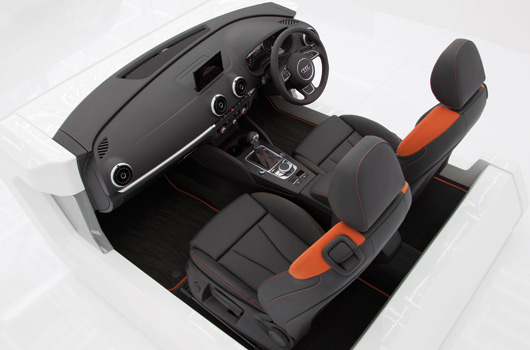
(Image has been flipped by AUSmotive to illustrate RHD layout)
Las Vegas, 2012-01-10
User control and display in the new Audi A3
In the new A3, Audi is further extending its classic strength – simple, easy-to-understand ergonomics. This compact car, which will be launched in many countries very soon, offers many advanced solutions.
One of these is an electromechanical parking brake, which replaces the mechanical component. Operation of the air conditioning system has been further enhanced. Many important functions can be controlled via the multifunction steering wheel – including a freely assignable button – and can be viewed in the driver information system display. The most interesting innovations, however, are in the area of infotainment – its hardware, software and user control.
Audi and Nvidia
“German engineering meets Silicon Valley†– a fitting slogan to describe Audi’s partnership with the Nvidia Corporation. Utilizing the fast graphic processors that the company supplies for many car model series, Audi has attained a leading position in the infotainment area. These processors have enabled innovations such as the world’s first integration of Google Earth images in the navigation map.
Audi and Nvidia began their joint venture in 2005. The A4, which appeared in 2007, already used a chip from this producer, which is based in Santa Clara, California. Two years later, the A8 attained a new dimension of visual display using Nvidia technology. Now, Audi and Nvidia are launching the next stage of their partnership – the new modular infotainment platform utilizes Tegra processors.
The modular infotainment platform
The Audi A3 is the first model of the brand to offer features from the modular infotainment platform. Audi is using this radically new architecture to solve a challenge that is becoming increasingly urgent – innovations in consumer electronics and rapid gains in computing power are being introduced at speeds that are much faster than the product cycles of automotive manufacturers.
The central computer in the modular infotainment platform, such as the one Audi currently uses, comprises two units – the Radio Car Control Unit and what is known as the MMX board (MMX: Multi-Media eXtension). The latter is a high-performance plug-in module which integrates – along with the working and flash memory – the latest Tegra processor from Nvidia; it is responsible for all voice control, online, media, navigation and telephone functions. The new modular layout makes it easy to update the hardware – the fact that the MMX board can be replaced keeps the system at the cutting edge of technology.
In the new A3, the T 20 processor of the Tegra 2 series from market leader Nvidia is used – it is a dual-core processor with 1.2 GHz clock frequency and a fast graphics card. It accelerates playback of many audio and video formats such as mp3 audio and mpeg4 video, which now dominate in the world of mobile entertainment.
The T 20 processor works together with a graphics program (what is known as a 3D engine) from the specialist Rightware – making Audi the first automobile manufacturer able to display three-dimensional graphics in a vehicle. The new A3 is saved as a data model in the system. Its drivers and passengers can view it virtually in detail and from many angles in the “Car†menu on the MMI navigation plus system. An all-new preview window has been integrated into the main menu.
In 2012, the next generation of processors will already be making its way into Audi cars – the Tegra 30, which Nvidia recently introduced. With built-in quad-core technology, it operates at up to 1.4 GHz clock frequency. As in the T 20, its power requirements are minimal – which fits in perfectly with Audi’s efficiency strategy. Nvidia is planning even more powerful chips for upcoming years, and Audi will introduce them in its cars soon after they appear.
e.solutions GmbH
The software that runs on the MMX boards also has a modular structure, and Audi developed the software largely independent of the hardware. In mid-2009 e.solutions GmbH was founded – a joint venture between Audi Electronics Venture GmbH, a fully owned subsidiary of AUDI AG, and Elektrobit Automotive GmbH, a division of the Finnish IT company Elektrobit. Audi contributes its knowledge of automotive infotainment to the partnership, while Elektrobit contributes its competence as a globally active software company in the infotainment and system integration fields.
More than 150 software specialists at the young company’s facilities in Ingolstadt and Erlangen are working to develop new modular infotainment solutions. e.solutions GmbH purchases functional software on the global market, e.g. for navigation or telephony, and integrates it into the e.solutions software suite.
New MMI terminal with touchwheel
Along with voice control, the MMI terminal is also used to control the many infotainment functions in the new Audi A3; it is located on the center tunnel console. Engineers designed a new interface from the ground up, giving special consideration to the slim center tunnel console compact Audi model.
The central component here is the touchwheel – which merges the touchpad and rotary pushbutton into a single part for the first time. The round pushbutton has a cap with a touch-sensitive surface that lets users enter characters by finger movement. The handwriting recognition system is of the highest quality, and the large touchwheel moves with high precision, and clicks precisely into place. The pad has a ring surround that is illuminated by an LED and a light conductor.
Two rocker switches in front of the touchwheel directly operate the most important areas of Telephone/Navigation and Media/Radio, while a Menu key and a Back key complete the key set. The four softkeys for navigating through the menus are also chrome, as are the two rocker switches that are used for direct operations. A volume control with integrated skip function completes the MMI terminal in the new Audi A3 and makes it possible to operate it intuitively.
Audi has completely revised not only the operation, but also the structure and many details of the menu. In the media area, for instance, the player and media center are clearly separated; titles, albums and artists can be located directly via free text search. The POI search in the navigation system has been simplified; traffic information can be called up via the map. The connect services have been grouped in their own menu; the Audi drive select control system is operated via the CAR menu, and many functions in the telephone area have been improved.
The new monitor
The displays in the new Audi A3 can be viewed on a monitor with a 7-inch diagonal. Thanks to its very high contrast and resolution of 800 x 480 pixels, it delivers brilliant, very sharp 3D graphics; highly efficient LEDs supply its backlighting. The display extends electrically from the instrument panel in an elegant movement, and it is slightly angled towards the driver. It is just 11 millimeters thick and is therefore almost as thin as an iPhone.
The monitor’s look is also reminiscent of the Apple cell phone – its cover glass plate is mounted directly to the surface of the TFT screen in a special lamination process. No air remains between the two components, and this improves optical performance. The painted housing is produced from ultra-light magnesium, which saves about 50 grams in weight. High gloss and chrome accents lend it an elegant touch.
The Audi Phone Box
Another option that is available in the new Audi A3 is the Audi Phone Box; it couples cell phones of any type to the vehicle perfectly. Its key component is a universal planar antenna, which is integrated in the center armrest’s phone storage tray.
The telephone utilizes near-field coupling to communicate with the flat planar antenna, which routes signals by wire to the vehicle antenna via an amplifier. The power supply for the cell phone runs via a USB port in the Audi Phone Box. Over the mid-term, Audi is working on a solution for contactless charging of cell phones.
The head-up display of the future
There are many Audi display and control technologies that make driving more relaxed and under control. One of them is the head-up display, which lets drivers keep their eyes on the road. All key information from the areas of navigation, traffic signs, car and assistance systems appear to hover about 2.3 meters (7.55 feet) in front of the driver, in his or her direct field of vision.
The next generation of this technology will take a significant step forward. A type of display known as the contact-analogue head-up display positions symbols right in the real environment. As an Audi approaches an intersection with the navigation system activated, the driver sees a transparent route arrow outside of the vehicle, positioned precisely at the real intersection. As the intersection nears, the arrow becomes larger. At a distance of 10 meters (32.81 feet), it appears to be about the same size as a real physical arrow on the pavement.
That is not all that contact-analogue head-up displays will be able to do. In hilly terrain, the navigation arrow can show the direction the road will take after the hilltop. If the driver is driving with adaptive cruise control activated, the distance to the vehicle ahead is displayed conspicuously. If the night vision system is active, and a pedestrian steps out onto the street, the display precisely shows the direction the pedestrian is coming from and his or her distance from the car. In the contact-analogue head-up display, the projection window – which is referred to as the ‘eyebox’ – is located somewhat higher on the windshield than today and is about as large as an iPad. Audi’s work on head-up displays is driving progress in all technology fields. In the future, it will be possible to show information only to the driver, the front seat passenger or all occupants of the vehicle.
The solution that Audi is presenting at the CES takes up this idea. The driver and front passenger each have their own head-up display available to them; the driver’s is contact-analogue, while the passenger has a conventional head-up display. Both displays show digital travel guides, news and pictures from video telephone calls. In the interest of safety, the driver is shown only static images and simple animations. If the passenger uses a wiping motion to pull the applications into his or her line of vision, all video functions become available.
Visible to all occupants is a central third projection, whose image appears to lie on the windshield. The driver or front passenger can move contents they are currently viewing to this central field with an easy, quick movement so that they can view it together. A camera detects the movements and directs the appropriate signals to the system.
The equipment, data and prices specified in this document refer to the model range offered in Germany. Subject to change without notice; errors and omissions excepted.
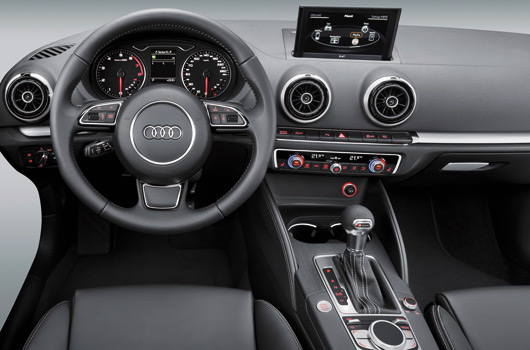
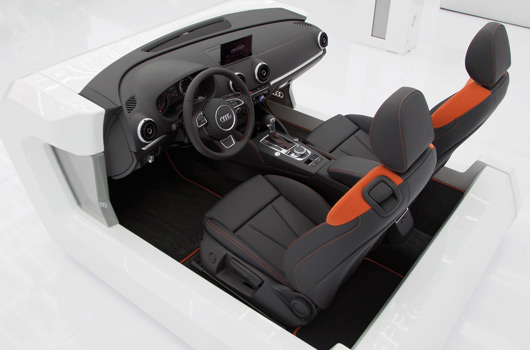
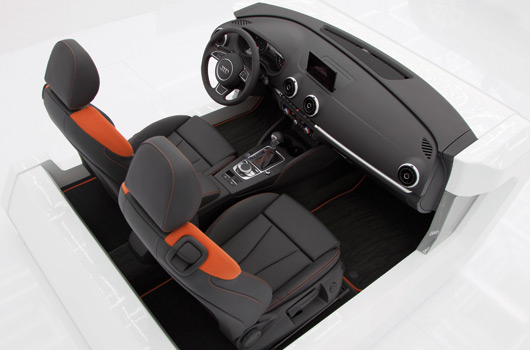
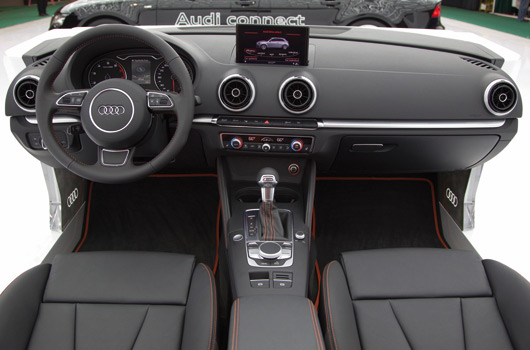
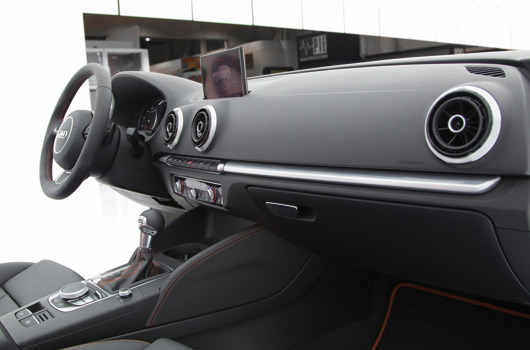
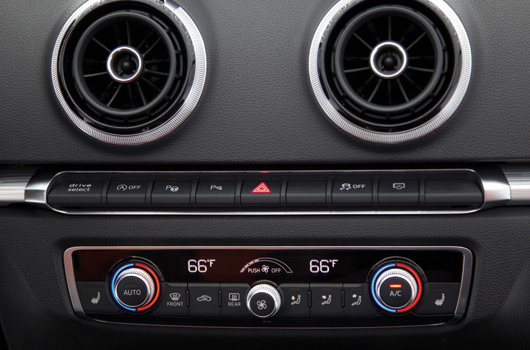
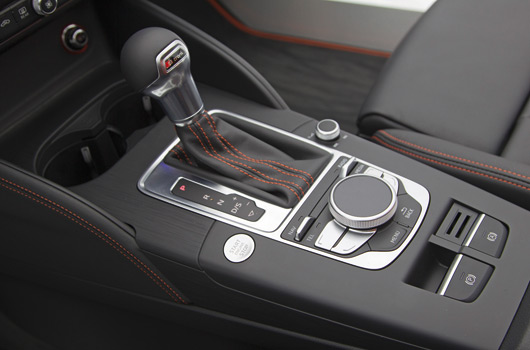
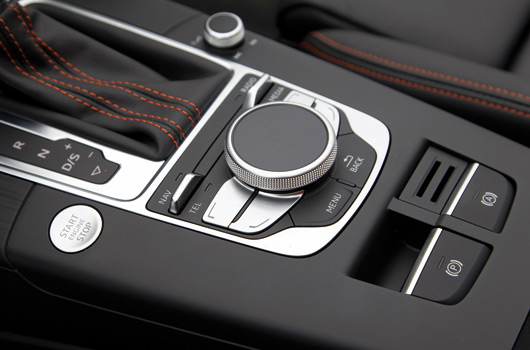
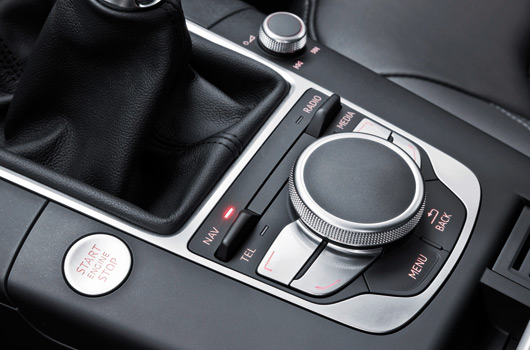
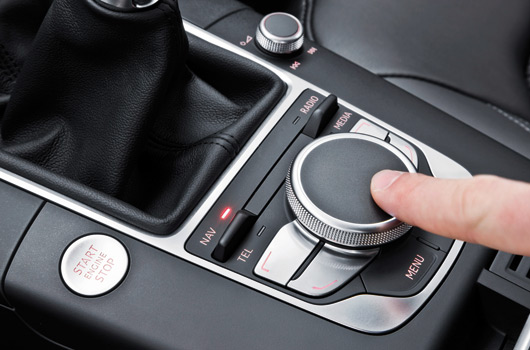
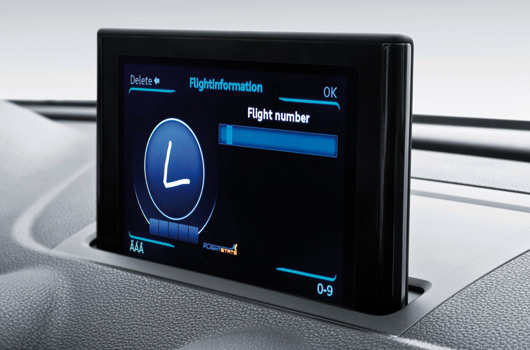

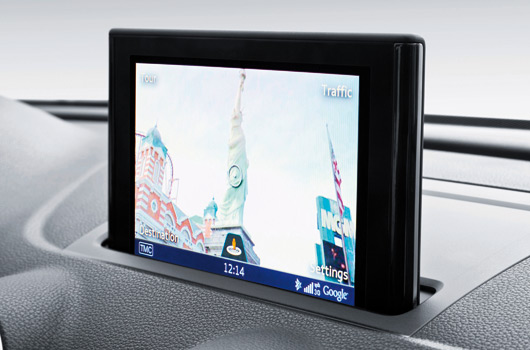
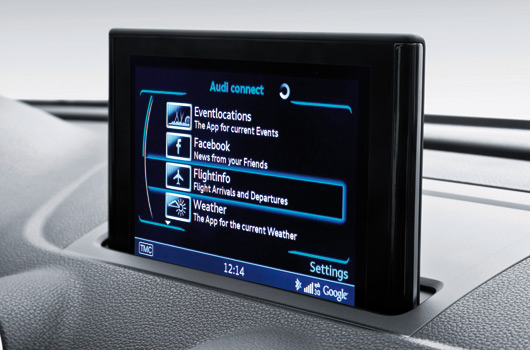
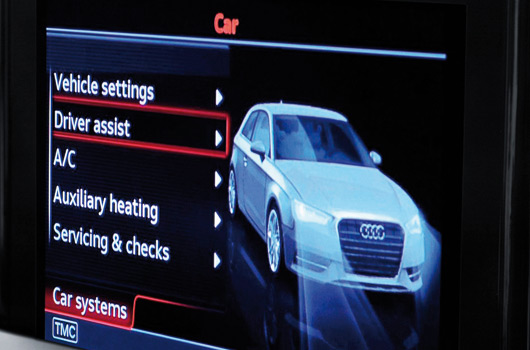
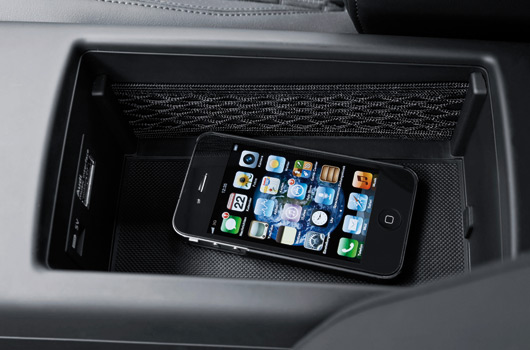
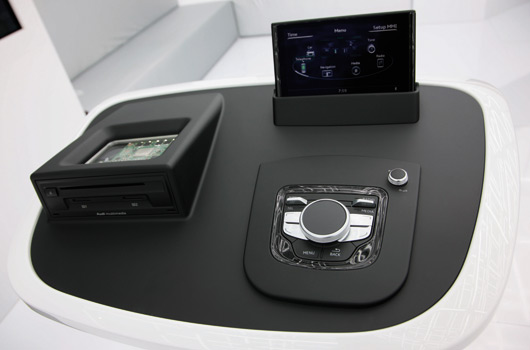
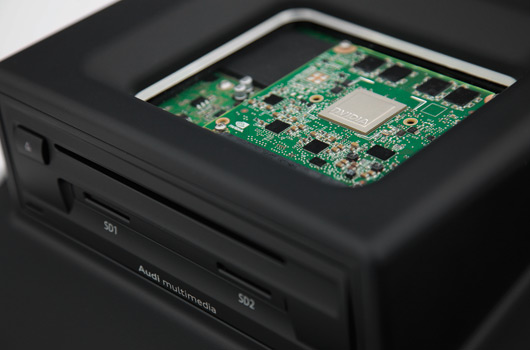
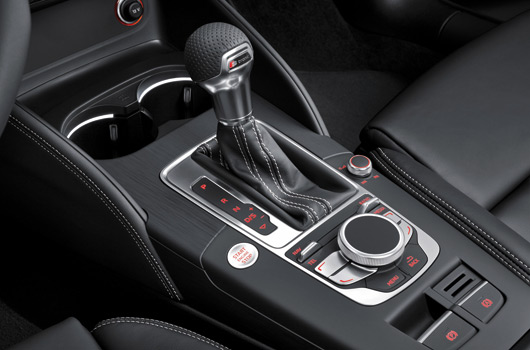
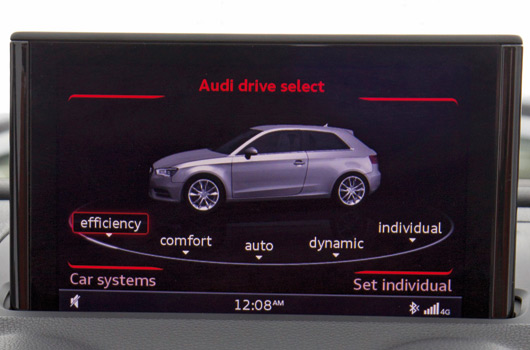
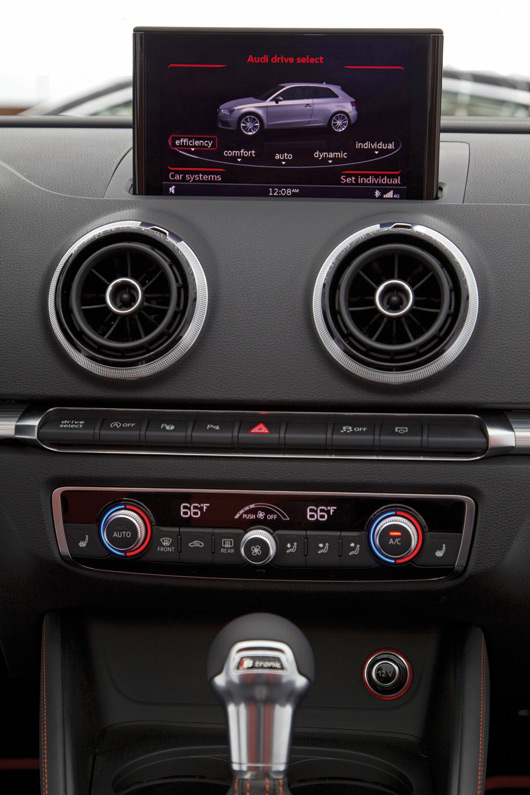
11 replies on “2012 Audi A3 interior (and more) revealed”
Looks freaking awesome. Good job Audi…
It go to see Nvidia and Google with Audi on this. What even great is that the GPU is replaceable with newer version, image putting in a GTX590 into this unit….
looks like a bmw with the idrive system lol.
I am loving the Audi Phone Box… cool idea!
[…] we brought you a bunch of pics of the new interior from the 2012 Audi A3. Within those images there were a few screen graphics showing an exterior rendering of the […]
awesome looking interior. Obviously chasing the changes made by BMW.
[…] Car magazine brings us a new selection of spy shots for the upcoming third-generation Audi A3. We’re likely to get a full reveal of the A3 at Geneva in March this year. We already have a pretty good idea of what to expect on the inside. […]
[…] has already given us an official look inside the new A3 and when you compare this image to the screen graphics you’ll see it’s a […]
[…] has already given us an official preview inside the new A3. When considering the exterior and interior styling it’s clear Audi has taken a considered […]
[…] interior of the new A3 is a nice step from the current 8P model and some of the ergonomic issues of that model have been […]
[…] we’ve seen inside the new A3 should translate to the Sportback. We reckon Audi has done enough to maintain their position as the […]